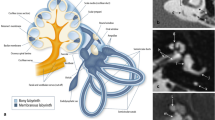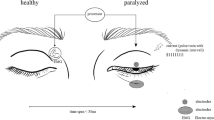Abstract
Vestibular neuritis (VN) mostly involves the superior portion of the vestibular nerve and labyrinth. This study aimed to describe the clinical features of VN involving the inferior vestibular labyrinth and its afferents only. Of the 703 patients with a diagnosis of VN or labyrinthitis at Seoul National University Bundang Hospital from 2004 to 2010, we retrospectively recruited 9 patients (6 women, age range 15–75) with a diagnosis of isolated inferior VN. Diagnosis of isolated inferior VN was based on torsional downbeating spontaneous nystagmus, abnormal head-impulse test (HIT) for the posterior semicircular canal (PC), and abnormal cervical vestibular-evoked myogenic potentials (VEMP) in the presence of normally functioning horizontal and anterior semicircular canals, as determined by normal HIT and bithermal caloric tests. All patients presented with acute vertigo with nausea, vomiting, and imbalance. Three patients also had tinnitus and hearing loss in the involved side. The rotation axis of torsional downbeating spontaneous nystagmus was best aligned with that of the involved PC. HIT was also positive only for the involved PC. Cervical VEMP was abnormal in seven patients, and ocular VEMP was normal in all four patients tested. Ocular torsion and subjective visual vertical tests were mostly within the normal range. Since isolated inferior VN lacks the typical findings of much more prevalent superior VN, it may be mistaken for a central vestibular disorder. Recognition of this rare disorder may help avoid unnecessary workups in patients with acute vestibulopathy.



Similar content being viewed by others
References
Dix MR, Hallpike CS (1952) The pathology symptomatology and diagnosis of certain common disorders of the vestibular system. Proc R Soc Med 45:341–354
Baloh RW (2003) Clinical practice. Vestibular neuritis. N Engl J Med 348:1027–1032
Strupp M, Brandt T (2009) Vestibular neuritis. Semin Neurol 29:509–519
Schuknecht HF, Kitamura K (1981) Second Louis H. Clerf Lecture. Vestibular neuritis. Ann Otol Rhinol Laryngol Suppl 90:1–19
Sando I, Black FO, Hemenway WG (1972) Spatial distribution of vestibular nerve in internal auditory canal. Ann Otol Rhinol Laryngol 81:305–314
Fetter M, Dichgans J (1996) Vestibular neuritis spares the inferior division of the vestibular nerve. Brain 119(Pt 3):755–763
Halmagyi GM, Weber KP, Curthoys IS (2010) Vestibular function after acute vestibular neuritis. Restor Neurol Neurosci 28:37–46
Baloh RW, Kerber KA (2011) Clinical neurophysiology of the vestibular system, 4th edn. Oxford University Press, New York
Choi KD, Oh SY, Kim HJ, Koo JW, Cho BM, Kim JS (2007) Recovery of vestibular imbalances after vestibular neuritis. Laryngoscope 117:1307–1312
Aw ST, Fetter M, Cremer PD, Karlberg M, Halmagyi GM (2001) Individual semicircular canal function in superior and inferior vestibular neuritis. Neurology 57:768–774
Monstad P, Okstad S, Mygland A (2006) Inferior vestibular neuritis: 3 cases with clinical features of acute vestibular neuritis, normal calorics but indications of saccular failure. BMC Neurol 6:45
Halmagyi GM, Aw ST, Karlberg M, Curthoys IS, Todd MJ (2002) Inferior vestibular neuritis. Ann N Y Acad Sci 956:306–313
Zhang D, Fan Z, Han Y, Yu G, Wang H (2010) Inferior vestibular neuritis: a novel subtype of vestibular neuritis. J Laryngol Otol 124:477–481
Newman-Toker DE, Kattah JC, Alvernia JE, Wang DZ (2008) Normal head impulse test differentiates acute cerebellar strokes from vestibular neuritis. Neurology 70:2378–2385
Halmagyi GM, Aw ST, Cremer PD, Curthoys IS, Todd MJ (2001) Impulsive testing of individual semicircular canal function. Ann N Y Acad Sci 942:192–200
Halmagyi GM, Curthoys IS (1988) A clinical sign of canal paresis. Arch Neurol 45:737–739
Halmagyi GM, Colebatch JG (1995) Vestibular evoked myogenic potentials in the sternomastoid muscle are not of lateral canal origin. Acta Otolaryngol Suppl 520:1–3
Choi KD, Oh SY, Park SH, Kim JH, Koo JW, Kim JS (2007) Head-shaking nystagmus in lateral medullary infarction: patterns and possible mechanisms. Neurology 68:1337–1344
Aw ST, Todd MJ, Aw GE, McGarvie LA, Halmagyi GM (2005) Benign positional nystagmus: a study of its three-dimensional spatio-temporal characteristics. Neurology 64:1897–1905
Blanks RH, Curthoys IS, Markham CH (1975) Planar relationships of the semicircular canals in man. Acta Otolaryngol 80:185–196
Della Santina CC, Potyagaylo V, Migliaccio AA, Minor LB, Carey JP (2005) Orientation of human semicircular canals measured by three-dimensional multiplanar CT reconstruction. J Assoc Res Otolaryngol 6:191–206
Lee H, Kim HJ, Koo JW, Kim JS (2009) Superior divisional vestibular paresis in anterior inferior cerebellar artery infarction. J Neurol Sci 285:250–253
Choi KD, Oh SY, Kim HJ, Kim JS (2007) The vestibulo-ocular reflexes during head impulse in Wernicke’s encephalopathy. J Neurol Neurosurg Psychiatr 78:1161–1162
Kim S, Lee HS, Kim JS (2010) Medial vestibulospinal tract lesions impair sacculo-collic reflexes. J Neurol 257:825–832
Kim S, Kim HJ, Kim JS (2011) Impaired sacculocollic reflex in lateral medullary infarction. Front Neurol 2:8
Suzuki JI, Cohen B (1964) Head, eye, body and limb movements from semicircular canal nerves. Exp Neurol 10:393–405
Leigh RJ, Zee DS (2006) The neurology of eye movements, 4th edn. Oxford, New York
Perez N, Rama-Lopez J (2003) Head-impulse and caloric tests in patients with dizziness. Otol Neurotol 24:913–917
Weber KP, Aw ST, Todd MJ, McGarvie LA, Curthoys IS, Halmagyi GM (2008) Head impulse test in unilateral vestibular loss: vestibulo-ocular reflex and catch-up saccades. Neurology 70:454–463
Weber KP, Aw ST, Todd MJ, McGarvie LA, Curthoys IS, Halmagyi GM (2009) Horizontal head impulse test detects gentamicin vestibulotoxicity. Neurology 72:1417–1424
Jorns-Haderli M, Straumann D, Palla A (2007) Accuracy of the bedside head impulse test in detecting vestibular hypofunction. J Neurol Neurosurg Psychiatr 78:1113–1118
Brandt T (1999) Vertigo: its multisensory sndromes, 2nd edn. Springer, London
Pavlou M, Wijnberg N, Faldon ME, Bronstein AM (2003) Effect of semicircular canal stimulation on the perception of the visual vertical. J Neurophysiol 90:622–630
Kim JS, Lee H (2009) Inner ear dysfunction due to vertebrobasilar ischemic stroke. Semin Neurol 29:534–540
Rosengren SM, Welgampola MS, Colebatch JG (2010) Vestibular evoked myogenic potentials: past, present and future. Clin Neurophysiol 121:636–651
Welgampola MS, Colebatch JG (2005) Characteristics and clinical applications of vestibular-evoked myogenic potentials. Neurology 64:1682–1688
Curthoys IS (2010) A critical review of the neurophysiological evidence underlying clinical vestibular testing using sound, vibration and galvanic stimuli. Clin Neurophysiol 121:132–144
Curthoys IS, Iwasaki S, Chihara Y, Ushio M, McGarvie LA, Burgess AM (2011) The ocular vestibular-evoked myogenic potential to air-conducted sound; probable superior vestibular nerve origin. Clin Neurophysiol 122:611–616
Curthoys IS, Manzari L (2011) Evidence missed: ocular vestibular-evoked myogenic potential and cervical vestibular-evoked myogenic potential differentiate utricular from saccular function. Otolaryngol Head Neck Surg 144:751–752
Goebel JA, O’Mara W, Gianoli G (2001) Anatomic considerations in vestibular neuritis. Otol Neurotol 22:512–518
Acknowledgments
This study was supported by a grant from the Korea Health 21 R&D Project, Ministry of Health & Welfare, Republic of Korea (A080750).
Conflicts of interest
J.-S. Kim serves as an Associate Editor of Frontiers in Neuro-otology and on the editorial boards of the Journal of Korean Society of Clinical Neurophysiology, Research in Vestibular Science, Journal of Clinical Neurology, Frontiers in Neuro-ophthalmology, Journal of Neuro-ophthalmology, and Case Reports in Ophthalmological Medicine; and has received research support from SK Chemicals Co., Ltd.
Author information
Authors and Affiliations
Corresponding author
Electronic supplementary material
Below is the link to the electronic supplementary material.
Video 1. A patient (patient 1) with right inferior vestibular neuritis shows spontaneous nystagmus with counterclockwise torsional (from the patient’s perspective) and downbeat components. The downbeat component is more prominent in the contralesional left eye. The horizontal component was minimal. (MPG 5,864 kb)
Video 2. Head-impulse test is abnormal only for the left posterior semicircular canal in a patient (patient 2) with left inferior vestibular neuritis. (MPG 5,102 kb)
Video 3. Follow-up examination 2 days later shows normalized head-impulse test for left posterior semicircular canal after resolution of the symptoms and nystagmus in patient 2. (MPG 4,376 kb)
Rights and permissions
About this article
Cite this article
Kim, JS., Kim, H.J. Inferior vestibular neuritis. J Neurol 259, 1553–1560 (2012). https://doi.org/10.1007/s00415-011-6375-4
Received:
Revised:
Accepted:
Published:
Issue Date:
DOI: https://doi.org/10.1007/s00415-011-6375-4




